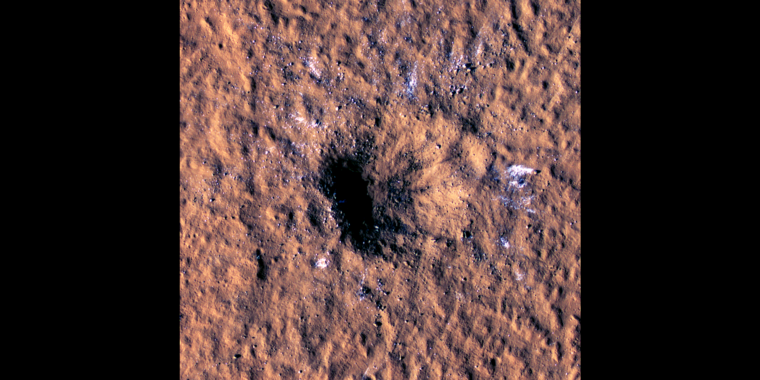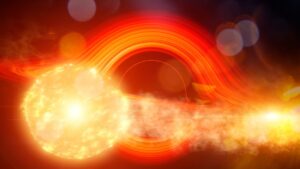Mars shakes with earthquakes, but not all of them are driven by phenomena that occur below the surface – many are the result of meteorite impacts.
Meteorites fall on Mars every day. After analyzing data from NASA’s InSight lander, an international team of researchers noticed that its SEIS seismometer had detected six nearby seismic events. They were linked to the same acoustic atmospheric signal that meteorites generate when they blast through the Martian atmosphere. Further investigation identified all six as part of an entirely new class of earthquakes known as VF (very high frequency) events.
The collisions that generate VF tremors occur in fractions of a second, much less time than the few seconds it takes for tectonic processes to cause earthquakes of similar size. These are some of the key seismological data that have helped us understand the occurrence of earthquakes caused by meteor impacts on Mars. It’s also the first time seismic data has been used to determine how often impact craters form.
“Although a non-impact origin cannot be definitively ruled out for every VF event, we show that the VF class as a whole is plausibly caused by meteorite impacts,” the researchers said in a study recently published in Nature.
Seismic displacement
Scientists have usually determined the approximate frequency of meteorite impact on Mars by comparing the frequency of craters on its surface with the expected impact rate calculated by counting lunar craters left by meteorites. Lunar cratering rate models were then adjusted to match Martian conditions.
Looking at the Moon as a base of comparison was not ideal, as Mars is particularly susceptible to being hit by meteorites. The Red Planet is not only a more massive body that has a greater gravitational pull, but it is located near the asteroid belt.
Another problem is that lunar craters are often better preserved than Martian craters because there is no dustier place in the Solar System than Mars. Craters in orbital images are often partially obscured by dust, making them difficult to identify. Sandstorms can complicate matters by covering craters with more dust and debris (something that can’t happen on the Moon due to the lack of wind).
InSight deployed its SEIS instrument after landing in the Elysium Planitia region of Mars. In addition to detecting tectonic activity, a seismometer can potentially determine the extent of an impact through seismic data. When meteorites hit Mars, they produce seismic waves just like tectonic earthquakes, and the waves can be detected by seismometers as they pass through the mantle and crust. A huge earthquake captured by SEIS is associated with a crater 150 meters (492 ft) wide. SEIS would later detect five more earthquakes, all of which were associated with an acoustic signal (detected by a different InSight sensor) that was the telltale sign of a falling meteorite.
Huge impact
Something else stood out about the six collision-induced earthquakes detected with seismic data. Because of the velocity of the meteorites (over 3,000 meters or 9,842 feet per second), these events occurred faster than any other type of earthquake, even faster than high-frequency (HF) earthquakes. That’s how they earned their own classification: very high frequency, or VF, earthquakes. When the InSight team used the Context Camera (CTX) on the Mars Reconnaissance Orbiter (MRO) to image the locations of the events captured by SEIS, there were new craters in the images.
There are additional seismic events that have not yet been attributed to craters. They are believed to be small craters formed by basketball-sized meteorites that are extremely difficult to see in orbital images from MRO.
The researchers were able to use SEIS data to estimate the diameters of the craters based on the distance from InSight (according to how long it took the seismic waves to reach the spacecraft) and the magnitude of the associated VF tremors. They were also able to derive the frequency of earthquakes recorded by SEIS. After the frequency estimate based on the data was applied to the entire Martian surface, they estimated that about 280 to 360 VF earthquakes occur each year.
“The case is strong that the route’s unique VF class is consistent with impacts,” they said in the same study. “It is therefore worth considering the implications of attributing all VF events to meteorite impacts.”
Their discovery added to the estimated number of impact craters on Mars, as many could not be seen from space before. What can the effects of VF tell us? The degree of impact on a planet or moon is important in determining the age of that object’s surface. Using impacts helped us determine that the surface of Venus is constantly renewed by volcanic activity, while most of the surface of Mars has not been covered by lava for billions of years.
Determining the speed of meteorite impacts could also help protect spacecraft and someday, perhaps, Martian astronauts from potential hazards. The study suggests that there are periods when impacts are more or less frequent, so it may be possible to predict when the sky is slightly more likely to be free of falling space rocks — and when it isn’t. Meteorites do not pose a great danger to Earth, as most of them burn up in the atmosphere. Mars has a much thinner atmosphere that more can pass through and no meteor shower umbrella.
Nature Astronomy, 2024 DOI: 10.1038/s41550-024-02301-z



